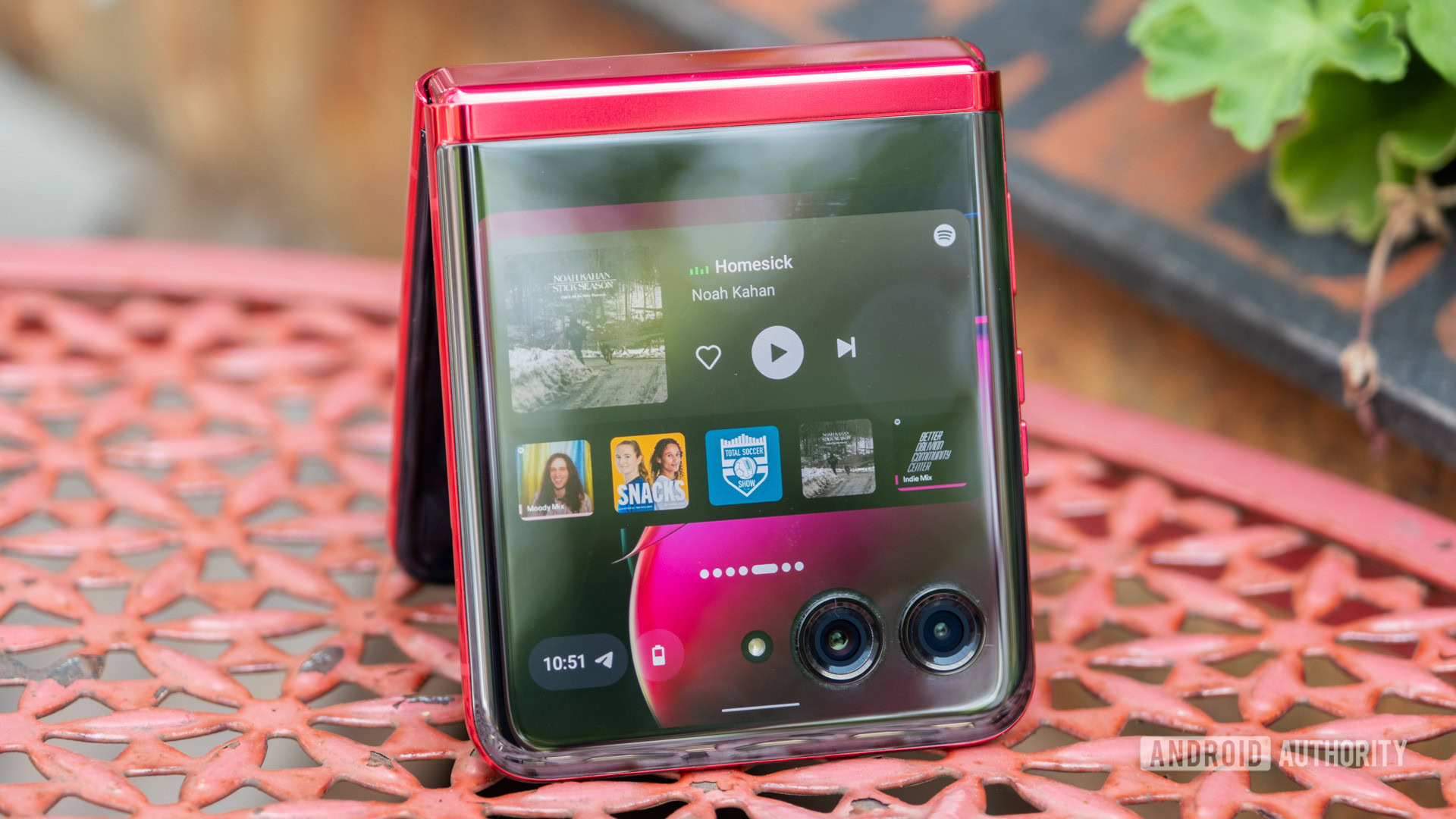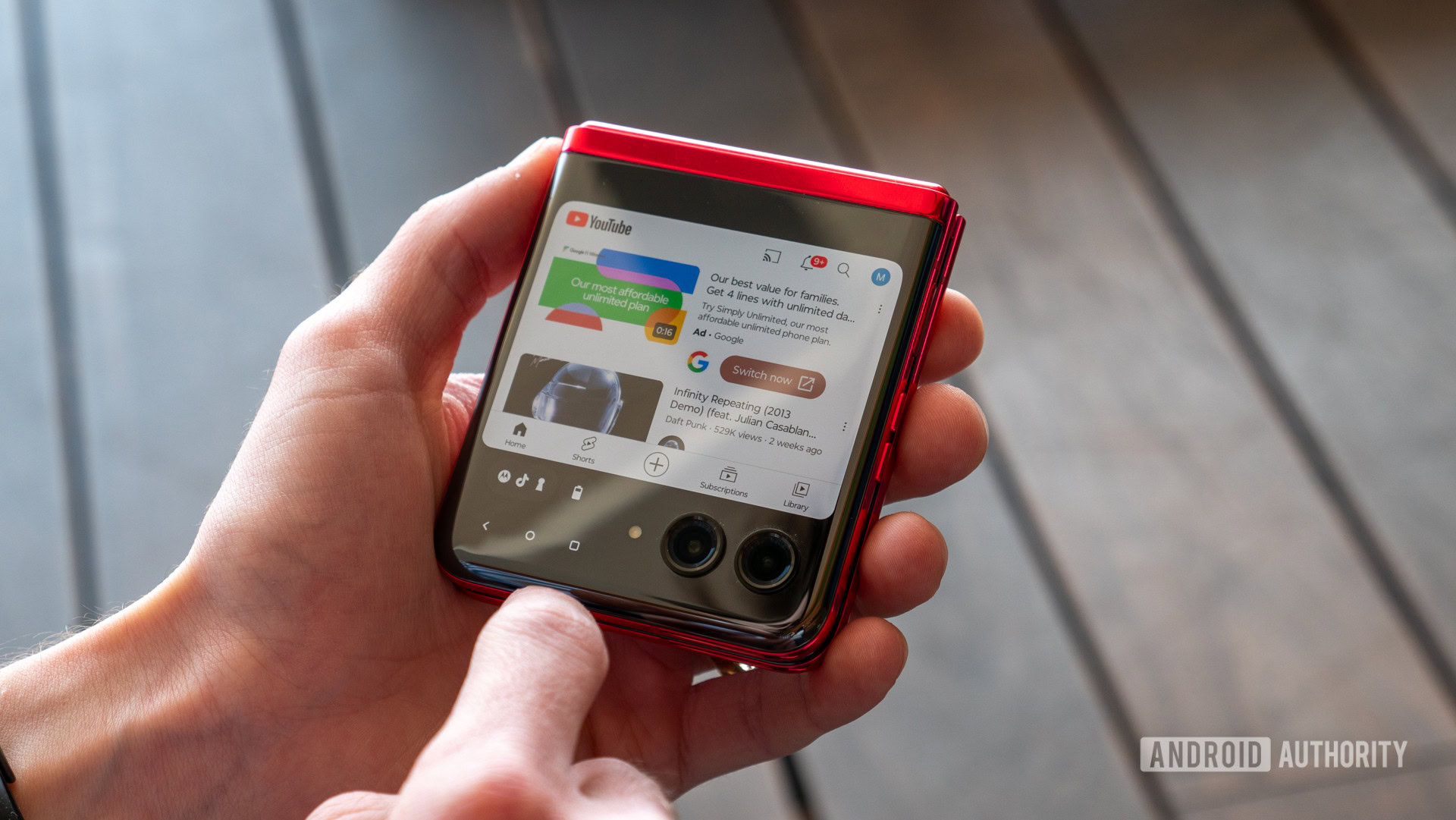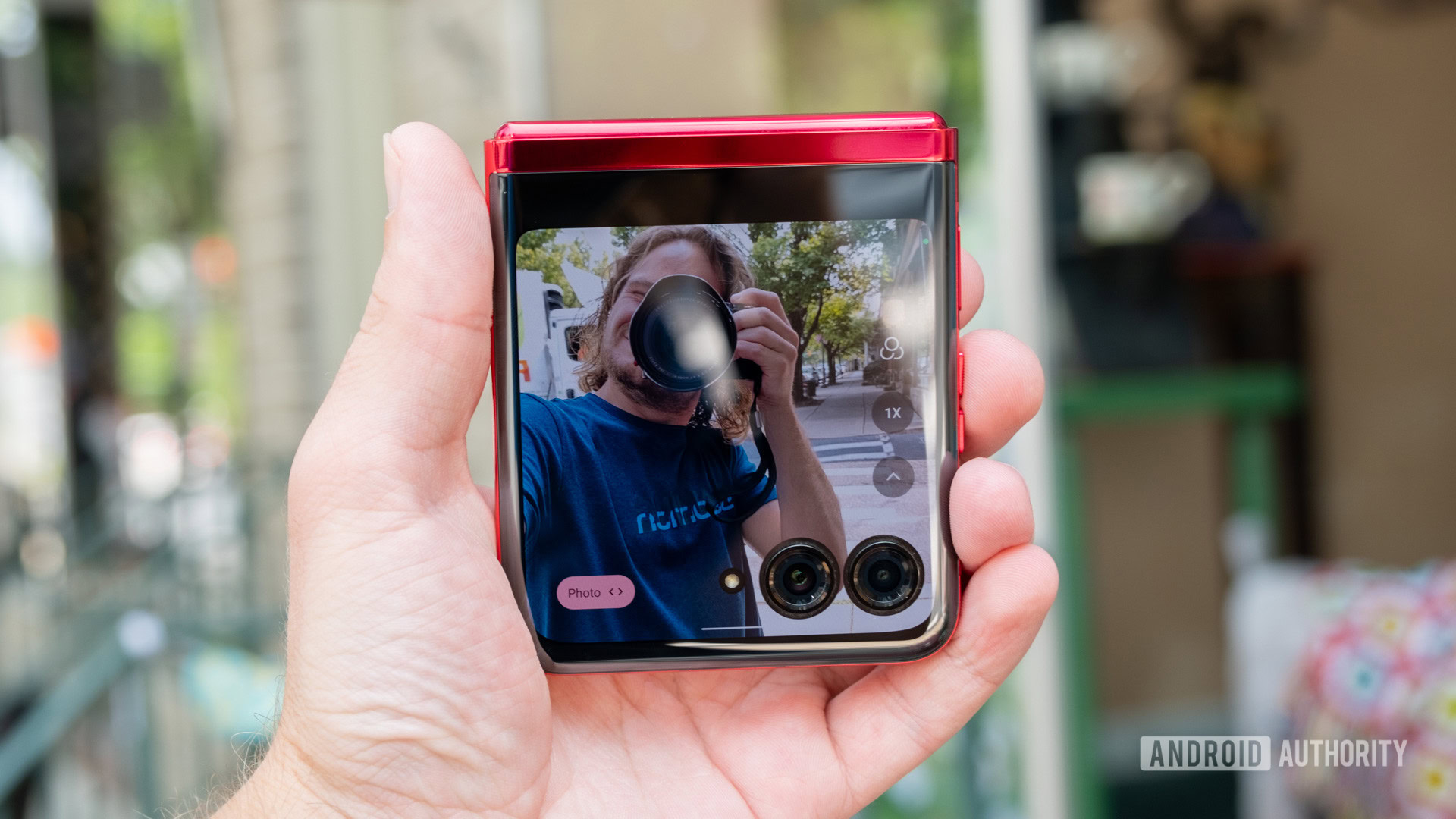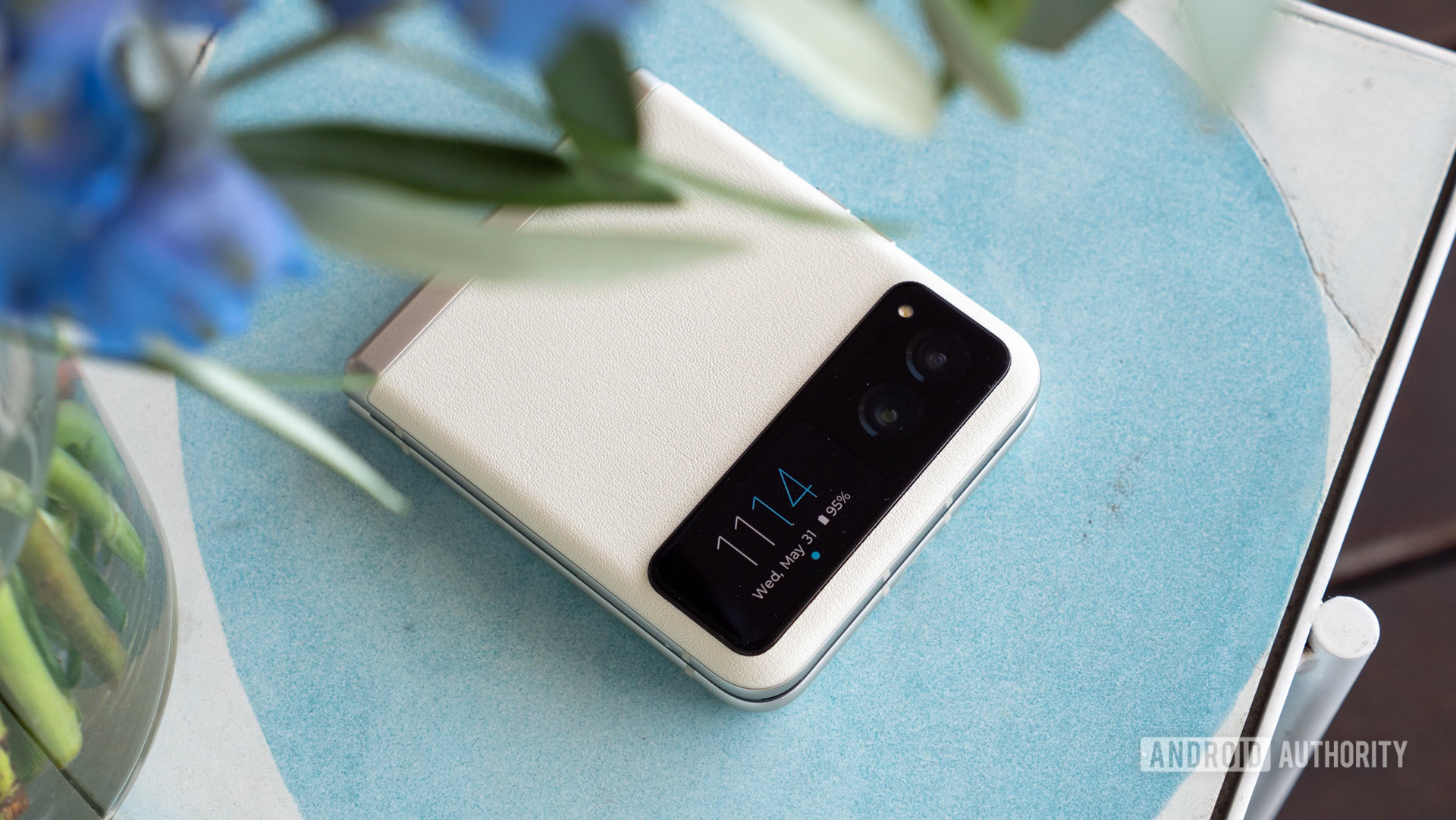Affiliate links on Android Authority may earn us a commission. Learn more.


Motorola Razr Plus review: Should you buy it?
Published onMarch 20, 2024

Motorola Razr Plus
What we like
What we don't like

Motorola Razr Plus
Motorola Razr Plus review: At a glance
- What is it? The Razr Plus is Motorola's most powerful, most refined entry into the foldable phone race and its first foldable to launch in the US since 2021. It pairs an internal 6.9-inch, 165Hz foldable display with a class-leading 3.6-inch cover display and a premium Snapdragon 8 Plus Gen 1 chipset.
- What is the price? The Motorola Razr Plus is available unlocked for $999 in the US, or you can pick up a sizable discount through your mobile carrier. If you're shopping internationally, the Razr Plus is branded as the Motorola Razr 40 Ultra and costs £1,049 in the UK or €1,199 throughout Europe.
- Where can you buy it? You can buy the Motorola Razr Plus unlocked from Motorola, Amazon, and Best Buy or pick it up on contract from major US carriers, including AT&T and T-Mobile. The Razr Plus opened for pre-orders on June 15, with broader sales opening a week later on June 23.
- How did we test it? I tested the Motorola Razr Plus for three weeks. The review unit was supplied by Motorola.
- Is it worth it? The Razr's return to the US was more than worth the wait. This is Moto's best clamshell foldable phone yet thanks to its capable cover screen, smooth software, and premium materials. While Motorola still has some work to do with its cameras and update commitment, the Razr Plus is a giant leap in the right direction.
Should you buy the Motorola Razr Plus?

After a few Razr-less years in the US, Motorola is back in a big way. Its new Razr Plus (or Razr 40 Ultra for international markets) is the company’s most refined foldable, combining the largest cover screen currently available on a clamshell with features and a pricing that take the fight directly to Samsung’s increasingly popular Galaxy Z Flip series. The Razr Plus also marks the first time Motorola has launched a series of clamshell devices, with the Razr Plus to be accompanied by the upcoming Razr (2023), which offers a smaller cover display and a more approachable price tag.
While it bears the Razr name, Motorola’s flagship foldable looks nothing like the flips that came before. It’s been completely redesigned inside and out, chopping some features (the chin) and stretching others (the cover display) to create one of the sleekest designs we’ve seen. That freshly expanded cover screen, loaded with far more functionality than Samsung could previously match, might be the Razr Plus’s stand-out feature — even more important than the 6.9-inch internal display.
I’ve been asked countless times during my weeks with the Razr Plus if I just folded my phone in half. People seem downright baffled by the fact that you can use Motorola’s 3.6-inch cover screen for almost all your daily needs — myself among them. I challenged myself to use only that cover screen for a full day and was pretty shocked by how well it handled my usage. Sure, there are tasks that you’ll prefer the internal display for, like scrolling through TikTok and managing your Spotify queue, but it’s tough to find something that you hands-down cannot do on the cover screen. You can even play full-fledged games like Asphalt 9 if you really want to. Tapping some of the smaller buttons is cramped and tricky, but you can do it.
At times, the cover display almost feels overpowered for what the Motorola Razr Plus needs. I wouldn’t trade that I can open Amtrak tickets, boarding passes, or the MLB Ballpark app on the cover screen, but I’m not sure that the 3.6-inch panel is best served with its 144Hz refresh rate. That refresh rate is faster than what you find on many flagship phones, and Motorola is using it on the equivalent of a GameBoy Advance. It’s still buttery smooth, but a slightly simpler panel might be kinder to the Razr Plus’s limited battery capacity — something we’ll return to in a bit.
Beyond the 3.6-inch Gorilla Glass Victus panel, the Motorola Razr Plus continues to sport a who’s who of premium materials. Its back panel is either Gorilla Glass Victus or vegan leather, depending on the model you go for, the frame is made from 7000-series aluminum, and the hinge is stainless steel. Motorola’s Razr Plus also carries an official IP52 rating against water and dust, making it the first foldable with certified dust resistance, though notably, the waterproof rating is much lower than the Galaxy Z Flip’s IPX8. Part of Motorola’s ability to secure an official dust rating comes from its redesigned hinge, which also allows the Razr Plus to fold completely flat. There’s no gap between the front and back halves when in your pocket, preventing debris from settling in the middle. It’s pretty easy to position the Razr Plus hinge from around 45 to 135 degrees, though it snaps open or shut once you pass either angle. I’ve also noticed a bit of wiggle back and forth if I try to keep the Razr Plus at 90 degrees for use as a camcorder.
The Razr Plus continues to impress once you open it to unveil the 6.9-inch LTPO AMOLED panel. It’s even smoother than the cover display, offering a 165Hz refresh rate that drops as low as 1Hz when needed and up to 1,400 nits of peak brightness. Motorola’s redesigned hinge has the added benefit of a shallower, less defined crease across the middle of the display, but a crease nonetheless. In my experience, you rarely feel the crease, mostly because very few apps require you to scroll past the middle of your phone anyway. More importantly, I never noticed the crease while watching movie trailers for Barbie and Oppenheimer, nor was it noticeable while hunting for tickets while sitting on a bright, sunny patio.
The Motorola Razr Plus has plenty of power under the hood, too. Motorola tapped Qualcomm’s Snapdragon 8 Plus Gen 1 chipset to power the premium clamshell, putting it on par with Samsung’s Galaxy Z Flip 4. It also offers similar supporting configurations, with 8GB of LPDDR5 RAM and 256GB of UFS 3.1 storage to back up the flagship chipset. However, Motorola is introducing its flagship foldable nearly a year after Samsung, and there’s a strong chance the newer Galaxy Z Flip 5 picks up a solid performance improvement with the Snapdragon 8 Gen 2 for Galaxy chipset.
Whether Motorola has the advantage on paper or not, the Razr Plus cruised through what I needed on a daily basis. The Snapdragon 8 Plus Gen 1 never stuttered, even with multiple apps running. However, I did notice the phone warming up a bit in my hand now and again, which might be due to the blistering refresh rate, relatively small battery, and limited space for cooling hardware.
Motorola's mix of smooth software and powerful internals makes the Razr Plus one of the most enjoyable foldable phones to use right now.
The Motorola Razr Plus ships with Android 13 right out of the box, with the company’s light, smooth My UX skin on top. It’s in line for three full Android updates and four years of security patches before Motorola ends support, which is a decent enough update policy. My UX is still one of the closest experiences you can get to stock Android, and it’s loaded with customization options for both the internal and external displays. You can manage everything from your cover screen wallpaper to the apps that show up in its smaller app drawer to the six tiles you can swipe through at a moment’s notice. It’s slightly odd that you can only choose six of Motorola’s tiles, given that there are a total of nine, but I have to assume that the choice was made to keep the clutter down. Thankfully, you can add almost every app on your phone to the cover screen app drawer, eliminating the need for extra tiles.
You will, however, occasionally run into some software hiccups as apps aren’t optimized to avoid the camera cutouts. Motorola explained that this was a way to get around the need to rework apps for the smaller display, and you can long-press the gestures pill to toggle the full display or push your app into a smaller window.

As for the cameras, the Motorola Razr Plus has what you could call the clamshell special. It pairs a 12MP primary camera with a 13MP ultrawide lens on the cover display and rounds them out with a 32MP punch-hole selfie shooter on the inside. While Motorola isn’t pushing the megapixels on the rear cameras, its primary lens offers an extremely wide maximum aperture of f/1.5, meaning you can get nice, shallow depth of field in portrait photos and plenty of light in low-light scenarios. The results that the Razr Plus puts out are good and fall in line with Samsung’s Galaxy Z Flip 4. However, Motorola’s image processing heavily favors green colors, pushing them beyond saturated on sunny days. You can check out a selection of full-size image samples at this Google Drive link.
Flip phones using the cover display as a camera preview is nothing new, but the Razr Plus offers a good reminder that size does matter. It’s much easier to preview your selfie — or TikTok dance, if you’re one of the content creators that Motorola is after — on the 3.6-inch panel than it ever was on the Galaxy Z Flip 4. I even used the Razr Plus to grab a 25-person shot of my running club without grabbing a random passerby, thanks to Motorola’s handy timer and the ability to trigger the shutter with the palm of your hand.
The Razr Plus still needs some image processing assistance, but the cover screen is a game-changer as a camera preview.
It’s pretty safe to say that Motorola didn’t pull many punches in designing and outfitting the Razr Plus. However, this much power has to come with sacrifices here and there. Unfortunately, the Razr Plus is good for just about 24 hours of battery life on a good day. You might be able to push into the morning of a second day of you’re mostly scrolling social media and using the cover display, but any extensive Spotify streaming or navigation and you’ll probably see worse returns. Motorola’s 3,800mAh battery is a hair larger than Samsung’s Galaxy Z Flip 5 cell, but the results are about the same. It can be tricky to track your true screen-on time with the Razr Plus, too, as Motorola’s software doesn’t factor the cover screen into its final tally.
When you drain the pocket-friendly battery, 30W wired charging means you can get back up and running quickly with a compatible charger. I was able to pick up around a 40% charge in just over half an hour, which was enough to get me through an evening at Camden Yards. A full charge takes about 80 minutes using wired charging, or you can place the Razr Plus on a Qi wireless pad for 5W speeds.


What are the best Motorola Razr Plus alternatives?

If you’re not sure that the Motorola Razr Plus is for you, there’s plenty of foldable competition to consider. Here are a few of the best clamshell options and one book-style pick for Pixel fans:
- Samsung Galaxy Z Flip 5 ($999.99 at Samsung): The Galaxy Z Flip 5 is currently Motorola’s closest rival, especially if you’re shopping in the US. Samsung’s expanded Flex Window remains slightly smaller than Motorola’s 3.6-inch panel, but the Galaxy Z Flip 5 offers a better update commitment and is the way to go if you’re a fan of One UI.
- OPPO Find N3 Flip ($1199 at Giztop): OPPO’s Find N3 Flip is its second entry into the clamshell competition, and it takes a different approach to Motorola or Samsung. The Find N3 Flip continues with a tall cover screen that sits to the side of its triple-camera setup — a first for a clamshell. Unfortunately, OPPO’s clamshell isn’t readily available for US buyers unless you’re willing to import one.
- Google Pixel Fold ($1799 at Amazon): The Google Pixel Fold might not have the same clamshell sensibilities, but it’s arguably the most convenient book-style foldable around. It offers a shorter, wider cover screen that feels like a traditional smartphone, while the 7.6-inch internal display adopts plenty of the Pixel Tablet’s better software features.
- Motorola Razr (2023) ($699.99 at Amazon): The Motorola Razr (2023) is a clamshell foldable for those who don’t need the huge cover screen. While it sacrifices some external functionality, Motorola’s more affordable model offers a 64MP primary camera and a larger 4,200mAh battery to stretch further through your day. All versions of the Motorola Razr (2023) also sport vegan leather back panels, so you don’t have to worry too much about drops or damage.
Motorola Razr Plus specs
| Motorola Razr Plus | |
|---|---|
Display | Internal: 6.9-inch LTPO pOLED 2,640 x 1,080 resolution (FHD+) 165Hz refresh rate 413ppi External: |
Processor | Snapdragon 8 Plus Gen 1 |
RAM | 8GB LPDDR5 |
Storage | 256GB UFS 3.1 |
Power | 3,800mAh battery 30W TurboPower wired charging 5W wireless charging |
Cameras | Rear: - 12MP wide, f/1.5, PDAF, OIS - 13MP ultrawide, f/2.2, 108-degree FoV Selfie: - 32MP wide, f/2.4 |
Audio | Stereo speakers Dolby Atmos 3 microphones |
Video | Primary: 4K at 30/60fps 1080p at 30/60fps Ultrawide: 4K at 30fps 1080p at 30fps |
Durability | Vegan leather or Gorilla Glass Victus back Ultra-thin glass display Aluminum frame IP52 rating |
Connectivity | Wi-Fi 6e Bluetooth 5.3 |
Biometrics | Side-mounted fingerprint reader |
Ports and switches | USB 2.0 via USB-C |
Software | Android 13 3 full Android updates 4 years of bi-monthly security updates |
Dimensions and weight | Open: 73.9 x 170.8 x 6.9mm Closed: 73.9 x 88.4 x 15.1mm 188.5 grams (glass back) 184.5 grams (vegan leather back) |
Colors | Infinite Black Glacier Blue Viva Magenta |
In the box | Motorola Razr Plus USB-C cable SIM ejector tool Quick start guide |
Motorola Razr Plus review: FAQ
Yes, the Motorola Razr Plus has a single nano-SIM tray and also supports eSIM.
Yes, the Razr Plus is available from AT&T, as well as T-Mobile. Although you can’t buy the Razr Plus directly from Verizon, you can bring an unlocked model to the network without issue.
The Motorola Razr Plus isn’t truly waterproof, though it does offer an IP52 rating against dust and splashes.
Yes, the Motorola Razr Plus supports 5W wireless charging.